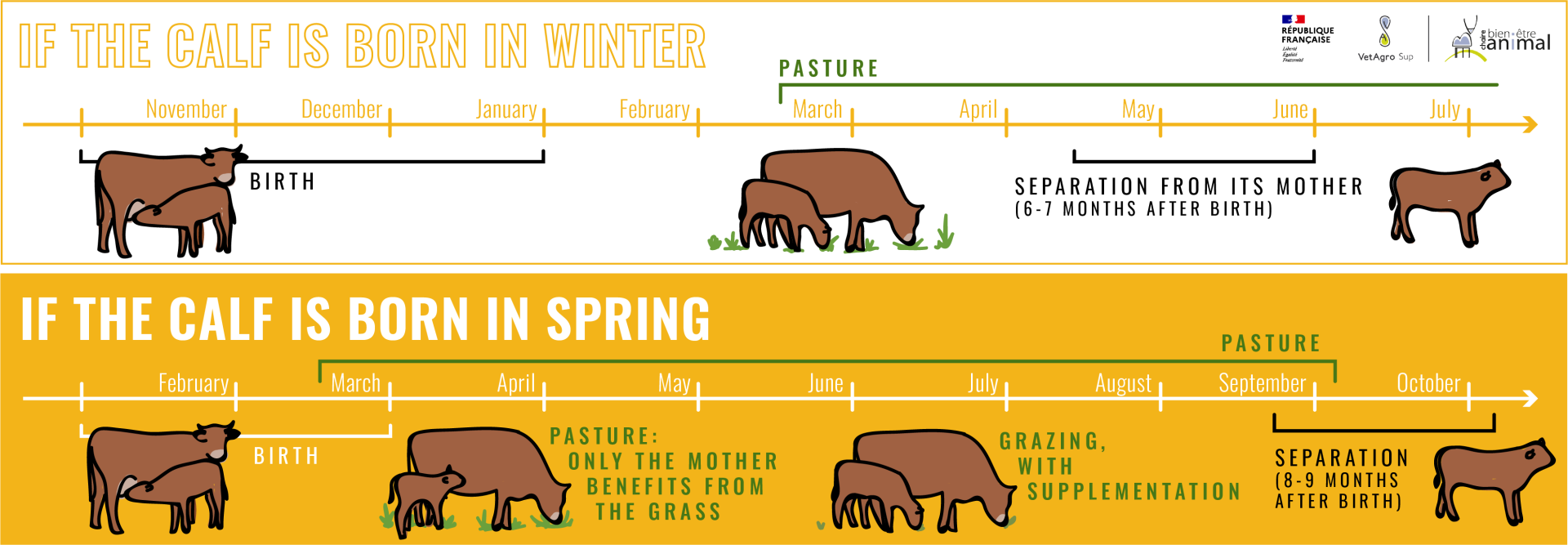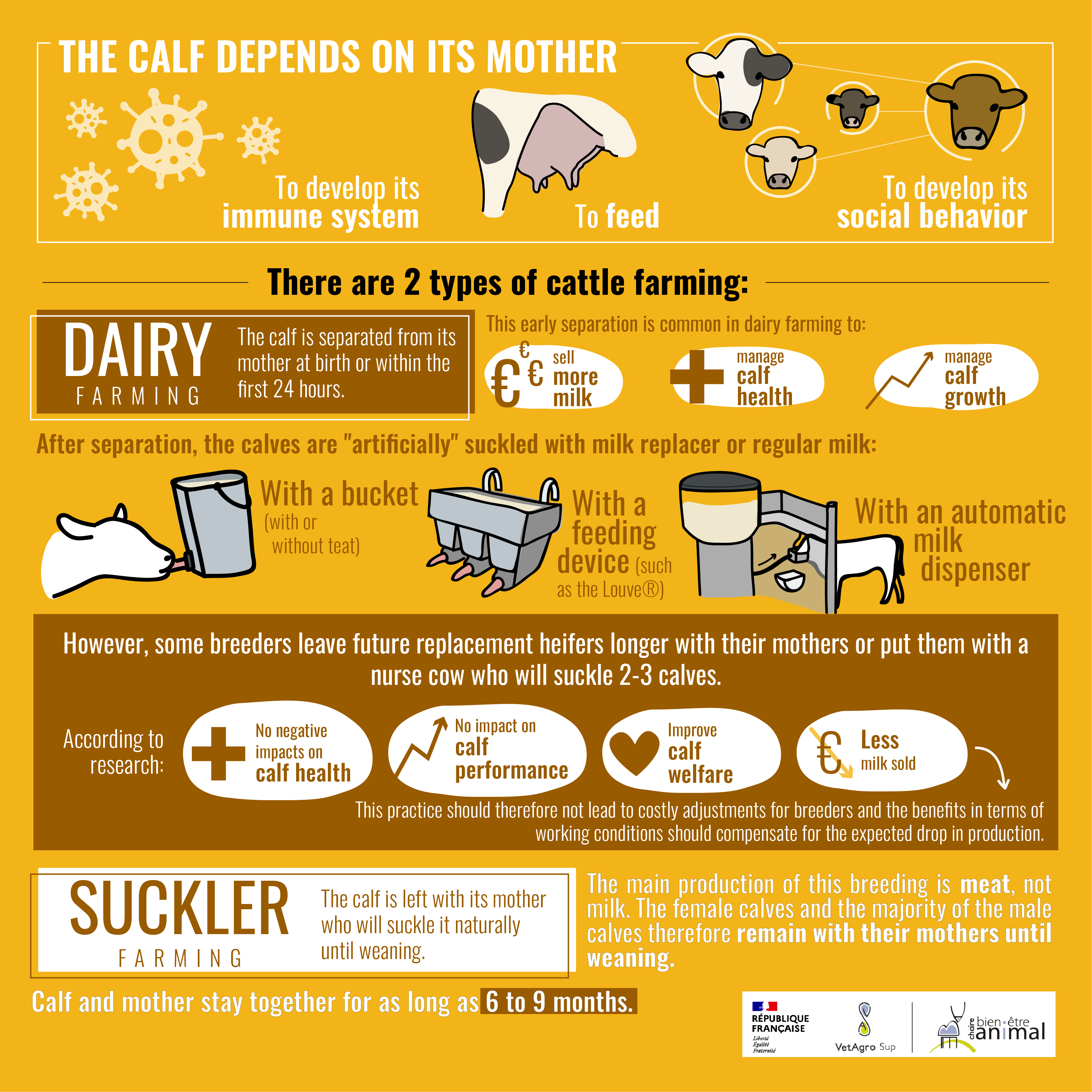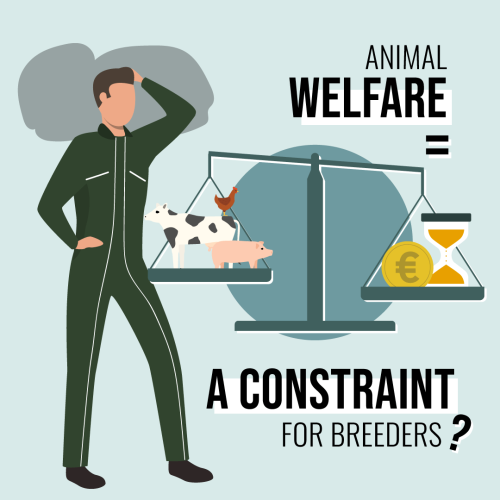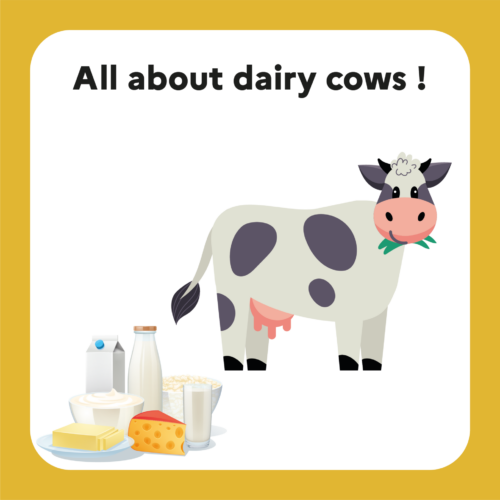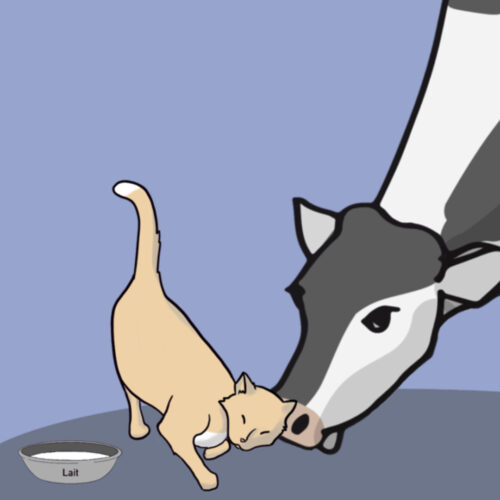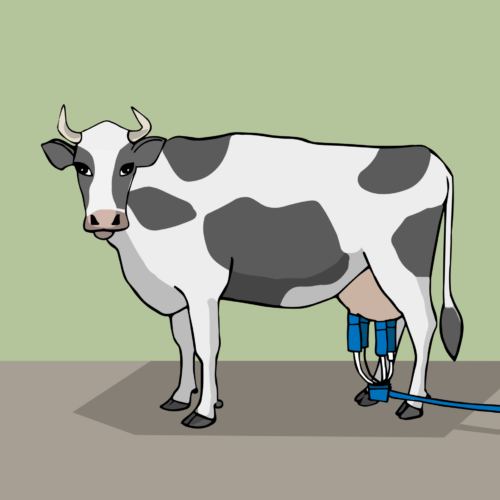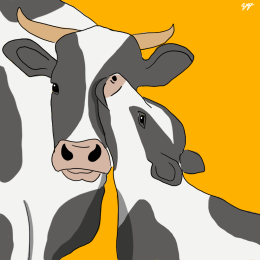

FALSE
There are two types of cattle breeding:
▫Dairy production, where calves are often separated from their mothers at birth, although new practices are developing.
▫Beef production, where calves stay with their mothers for several months.
Keep in mind
- The mother-calf bond is essential for the development of the calf's immune system, its nutrition and the development of its social behavior
- In dairy farms, the calf is generally separated from its mother within 24 hours, whereas in suckler farms, the calf is left with its mother until weaning
- However, new practices are being developed to improve the welfare of dairy calves: calves raised by nurse cows, calves left with their mothers for longer, etc.
The cow-calf bond
After birth, calves depend on their mothers for survival. Firstly, for the intake of colostrum[1], necessary for its immune protection – lacking at birth. But also for the satisfaction of its nutritional needs through maternal milk. Indeed, at the beginning of its life, the calf’s digestive system is not developed and so it cannot feed on solid food. Only the abomasum[2] is functional and allows it to digest milk. Then progressively, from 2-3 weeks, calves gradually and naturally begin to consume fibrous foods (grass, fodder, etc.), thus acquiring their adult digestive system.

Did you know?
The adult bovine is polygastric, meaning it has several cavities: three forestomachs (the reticulum, the rumen and the folium) and the abomasum which is comparable to the actual stomach. The calf is monogastric, because only its abomasum is functional. During growth, its digestive system undergoes major physiological and anatomical changes which allow the forestomachs to function, making it a ruminant capable of digesting plant fibers.
Under natural conditions, this transition from milk to solid diet occurs gradually over several months until weaning – when milk feeding ceases, between 8 and 12 months of age, generally before the next calf’s birth[3].
The mother also plays a determining role in her calf’s behavioral development, by influencing its feeding behavior and facilitating the development of its social behavior[4]. Indeed, during its first few days, the mother is the calf’s only social partner and it is during this period that the cow-calf bond is built[5]. This bond is considered to be fully established 4 days after birth[6]. Then, little by little, while maintaining its preferential bond with its mother, the calf will interact more frequently with other young of the same age (sniffing, licking, head games, etc.), thus creating affinity relationships. Separation from the mother then occurs gradually. After the mother stops suckling, the bond goes on but the mother takes more and more care of her new calf.
Calf rearing in dairy farming
Early separation of the calf
In dairy cattle farms, newborns are generally separated from their mothers at birth or within the first 24 hours, in order to allow the calf to have its first “natural” intake of colostrum and build its immune system[7]. This sudden separation is a source of stress for both animals[8].
After separation from their mothers, calves are fed “artificially” from a bucket (with or without a teat), a feeding device such as the Louve® (a container with several teats), or an automatic milk dispenser. The feed is either whole milk (from milking), milk replacer (powder) diluted in hot water, or a combination of both. Calves are then weaned at around 12 weeks of age.
After being separated from their mother, calves are usually housed in individual hutches for a few weeks before being housed in groups. Individual housing allows for better management of health, feeding and growth.

Did you know?
The European directive on calf welfare [9] prohibits individual housing after 8 weeks of age. In its latest opinion, EFSA even recommends that calves be housed in pairs or small stable groups of 2 to 7 calves from their first week of life (before their 7th day).
The calves’ fate then depends on their sex. Female calves are primarily raised for herd renewal, meaning they are intended to become future dairy cows, with their first calving anticipated between 24 and 36 months, depending on the breed. Typically, they stay on the farm where they were born for their entire lives. Male calves are raised for meat production and are typically processed as follows: 61% are processed as veal before 8 months of age, 12% are processed as young cattle before 24 months, and 6% are processed as beef at 30 to 36 months of age[10]. They are usually transferred from their birth farm to specialized fattening farms at approximately 3 weeks of age.
The early separation of mother and calf has been a traditional practice in dairy farming for many years and remains prevalent today. This approach is advocated because it is believed to increase milk sales (milk has more value than milk replacer), facilitate better management of the calf’s intake of colostrum and milk—thereby improving growth and health—and because it is thought that the signs of stress in the calf are minimal when separation occurs promptly after birth.
However, this practice does not respect the animals’ natural behavior and is increasingly controversial, particularly in regard to animal welfare[11]. Thus, EFSA, in its latest opinion on calf welfare, recommends that dairy calves be left with their mother for at least one day after birth[12].
Practices encouraging cow-calf contact during the first weeks are therefore developing, even if they are still relatively uncommon[13].
New practices
Some dairy farmers choose “natural” breastfeeding for future replacement heifers, leaving them longer with their mothers or putting them with a nurse cow who will suckle two or three calves. Depending on the practices, weaning takes place between 5 and 9 months.
In cow-nurse rearing, calves generally stay with their mother for a few days before being transferred to the nurse. Adoption is an important process and generally several calves are adopted at the same time. The nurses are chosen from cows that produce less milk or that have good maternal behavior, favoring adoption. In this breeding style, the calf and its nurse stay together permanently until the calf is weaned.
In cow-calf rearing, contact between mother and calf can vary from constant contact to short-term contact several times a day[14]. In addition, mother and calf may be isolated from the rest of the herd for a few days after calving to promote cow-calf bonding, or may remain in the group of cows about to calve.
In addition, mother and calf may be isolated from the rest of the herd for a few days after calving to promote cow-calf bonding, or may remain in the group of cows about to calve[15].
In addition, breastfeeding, although less controlled than artificial breastfeeding, has no negative impact on the health of calves (as long as colostrum quantity and quality are adapted). Breeders who raise calves with mothers or nurses mostly even observe an improvement in the health of calves (reduction in the frequency of diarrhea, respiratory diseases) and cows (reduction in the number of mastitis, improvement in fertility)[16].
There is a consensus on the positive effect (or at least the absence of negative effects) on the overall growth of calves weaned later and more gradually[17]. However, this also means that suckler cows provide less milk for sale.

Did you know?
Separation stress (agitation, vocalizations, etc.) is greater if separation occurs after the cow-calf bond has been established than if it occurs directly after birth[18]. On the other hand, once the bond has been established, stress decreases as weaning occurs later, presumably because the calf is less dependent on its mother for feeding [19].
To ensure the successful implementation of these new practices, several key factors must be considered, including: effective adoption management, establishing a strong human-animal bond with young calves, supplemental nutrition for nurse cows, etc[20]. Furthermore, to maintain economic viability, cow-calf or nurse-calf rearing should not imply costly infrastructure upgrades. Any potential improvements in terms of labor duration, constraints, or hardship, must at least compensate for the drop in production.
Suckling calf rearing
As the name suggests, in suckler farming, the calf is left with its mother who will suckle it naturally until weaning. The calf can therefore suckle its mother as it pleases and weaning is gradual. This practice is made possible because the main production of such farming type is meat, not milk – which is used to suckle the calf, not sold. It concerns both female calves and the vast majority of male calves. The majority of female calves will become replacement heifers. The majority of males will be slaughtered around the age of 18-24 months, after a fattening period. A few male calves are raised as suckling calves and sold as veal. They have a slightly different breeding method. In order to control their feeding and fattening, they are not left permanently with their mothers but are instead fed at fixed times, determined by the breeder.
Traditionally, calf and mother remain together for as long as 6 to 9 months. This corresponds to what is observed in natural conditions. The age of separation depends partly on the calving season. In fact, breeding systems are based on grass growth, which makes it possible to make the most of agricultural land and provide low-cost feed for the calves’ growth or the mothers’ milk production.
Indeed, if a calf is born during the winter (between November and January), it will go out to pasture with its mother around March and will start to enjoy spring grass for its growth. It will be separated from its mother before summer (around June) to be sold to a fattening breeder, for fattening or breeding.
If born in spring (between February and the end of March), the calf will also go out to pasture with its mothers but will not benefit from spring grass for its growth because its digestive system will not yet be developed. The mothers will benefit from the grass to produce milk and suckle their calves. Calves can start grazing on grass in summer, but during that period the slow grass growth requires supplementing them with fodder. Also, to take advantage of the grass that grows again in September, calves are generally kept with their mothers and sold in the fall (end of September or October).
In short
Additional information
See this article by the Institut de l’élevage (Idele): https://idele.fr/detail-article/replay-webinaire-bien-etre-et-elevage-des-veaux-les-nouveaux-enjeux
[1] Colostrum is the first milk ingested by the newborn after birth. It is very rich in proteins and antibodies, essential for the newborn’s immunity during its first days.
[2] The abomasum, also called maw, is the true stomach of ruminants, which secretes gastric juices. The other compartments, and in particular the rumen, are pre-stomachs which allow microbial digestion and therefore the degradation of fodder. It is during this digestion that methane – which contributes to global warming – is produced.
[3] Reinhardt, V., Reinhardt, A., 1981. Cohesive relationships in a cattle herd (Bos indicus). Behaviour 77, 121–150.
Whalin, L., Weary, D.M., von Keyserlingk, M.A.G., 2021. Understanding Behavioural Development of Calves in Natural Settings to Inform Calf Management. Animals 11. https://doi.org/10.3390/ani11082446
[4] Von Keyserlingk, M.A.G., Weary, D.M., 2007. Maternal behavior in cattle. Hormones and Behavior 52, 106–113. https://doi.org/10.1016/j.yhbeh.2007.03.015
Waiblinger, S., Wagner, K., Hillmann, E., Barth, K., 2020. Play and social behaviour of calves with or without access to their dam and other cows. Journal of Dairy Research 87, 144–147. https://doi.org/10.1017/S0022029920000540
[5] Von Keyserlingk, M.A.G., Weary, D.M., 2007. Maternal behavior in cattle. Hormones and Behavior 52, 106–113. https://doi.org/10.1016/j.yhbeh.2007.03.015
[6] Stěhulová, I., Lidfors, L., Špinka, M., 2008. Response of dairy cows and calves to early separation: Effect of calf age and visual and auditory contact after separation. Applied Animal Behaviour Science 110, 144–165. https://doi.org/10.1016/j.applanim.2007.03.028
[7] Le Cozler, Y., Recoursé, O., Ganche, E., Giraud, D., Danel, J., Bertin, M., Brunschwig, P., 2012. A survey on dairy heifer farm management practices in a Western-European plainland, the French Pays de la Loire region. J. Agric. Sci. 150, 518–533. https://doi.org/10.1017/S0021859612000032
[8] Weary, D.M., Jasper, J., Hötzel, M.J., 2008. Understanding weaning distress. Applied Animal Behaviour Science 110, 24–41. https://doi.org/10.1016/j.applanim.2007.03.025
[9] European Directive 2008/119/EC transposed into French law by the decrees of 20 January 1994 and 8 December 1997 (consolidated following the publication of the directive in 2008): https://www.legifrance.gouv.fr/jorf/id/JORFTEXT000020094940
[10] https://www.web-agri.fr/vaches-allaitantes-pmtva/article/221459/destination-des-veaux-laitiers-et-allaitants. The rest of the male calves are exported or intended for breeding.
[11] Placzek, M., Christoph-Schulz, I., Barth, K., 2021. Public attitude towards cow-calf separation and other common practices of calf rearing in dairy farming—a review. Org. Agr. 11, 41–50. https://doi.org/10.1007/s13165-020-00321-3
[12] EFSA Panel on Animal Health and Animal Welfare (AHAW), Nielsen, S.S., Alvarez, J., Bicout, D.J., Calistri, P., Canali, E., Drewe, J.A., Garin‐Bastuji, B., Gonzales Rojas, J.L., Gortazar Schmidt, C., Herskin, M., Michel, V., Miranda Chueca, M.A., Padalino, B., Pasquali, P., Roberts, H.C., Spoolder, H., Stahl, K., Velarde, A., Viltrop, A., Jensen, M.B., Waiblinger, S., Candiani, D., Lima, E., Mosbach‐Schulz, O., Van der Stede, Y., Vitali, M., Winckler, C., 2023. Welfare of calves. EFS2 21. https://doi.org/10.2903/j.efsa.2023.7896
[13] Pomiès, D., Constancis, C., Jurquet, J., Veissier, I., Caillat, H., Lagriffoul, G., Drouet, M., Fossaert, C., Le Cozler, Y., 2023. Devenir des jeunes ruminants laitiers : comment concilier élevage et attentes sociétales. INRAE Prod. Anim. 36. https://doi.org/10.20870/productions-animales.2023.36.1.7491
[14] Sirovnik, J., Barth, K., De Oliveira, D., Ferneborg, S., Haskell, M.J., Hillmann, E., Jensen, M.B., Mejdell, C.M., Napolitano, F., Vaarst, M., Verwer, C.M., Waiblinger, S., Zipp, K.A., Johnsen, J.F., 2020. Methodological terminology and definitions for research and discussion of cow-calf contact systems. Journal of Dairy Research 87, 108–114. https://doi.org/10.1017/S0022029920000564
[15] Waiblinger, S., Wagner, K., Hillmann, E., Barth, K., 2020. Play and social behaviour of calves with or without access to their dam and other cows. Journal of Dairy Research 87, 144–147. https://doi.org/10.1017/S0022029920000540
[16] Constancis, C., Ravinet, N., Bernard, M., Lehebel, A., Brisseau, N., Chartier, C., 2021. Rearing system with nurse cows and risk factors for Cryptosporidium infection in organic dairy calves. Preventive Veterinary Medicine 190, 105321. https://doi.org/10.1016/j.prevetmed.2021.105321
Eriksson, H., Fall, N., Ivemeyer, S., Knierim, U., Simantke, C., Fuerst-Waltl, B., Winckler, C., Weissensteiner, R., Pomiès, D., Martin, B., Michaud, A., Priolo, A., Caccamo, M., Sakowski, T., Stachelek, M., Spengler Neff, A., Bieber, A., Schneider, C., Alvåsen, K., 2022. Strategies for keeping dairy cows and calves together – a cross-sectional survey study. animal 16, 100624. https://doi.org/10.1016/j.animal.2022.100624
Vaarst, M., Hellec, F., Verwer, C.M., 2020. Cow calf contact in dairy herds viewed from the perspectives of calves, cows, humans and the farming system. Farmers’ perceptions and experiences related to dam-rearing systems. Landbauforschung : journal of sustainable and organic agricultural systems 49–57. https://doi.org/10.3220/LBF1596195636000
[17] Bouchon, M., Nicolao, A., Sturaro, E., Martin, B., Pomies, D., 2022. Allaitement maternel des veaux laitiers : quel compromis entre croissance des veaux, production laitière et bien-être animal ? Presented at the 26ème Rencontres autour des Recherches sur les Ruminants (3R 2022), Paris, France, p. pp 229-232.
Welk, A., Neave, H.W., Jensen, M.B., 2024. Invited review: The effect of weaning practices on dairy calf performance, behavior, and health – a systematic review. Journal of Dairy Science. https://doi.org/10.3168/jds.2024-24521
[18] Stěhulová, I., Lidfors, L., Špinka, M., 2008. Response of dairy cows and calves to early separation: Effect of calf age and visual and auditory contact after separation. Applied Animal Behaviour Science 110, 144–165. https://doi.org/10.1016/j.applanim.2007.03.028
Veissier, I., Caré, S., Pomiès, D., 2013. Suckling, weaning, and the development of oral behaviours in dairy calves. Applied Animal Behaviour Science 147, 11–18. https://doi.org/10.1016/j.applanim.2013.05.002
[19] EFSA Panel on Animal Health and Animal Welfare (AHAW) et al., 2023
[20] https://bretagne.chambres-agriculture.fr/mes-productions/elevage/bovins-lait/conduite-sante-repro-bien-etre/les-vaches-nourrices/ and https://www.phylum.fr/blog/la-pratique-de-lelevage-des-veaux-laitiers-sous-vaches-nourrices
Keep in mind
- The mother-calf bond is essential for the development of the calf's immune system, its nutrition and the development of its social behavior
- In dairy farms, the calf is generally separated from its mother within 24 hours, whereas in suckler farms, the calf is left with its mother until weaning
- However, new practices are being developed to improve the welfare of dairy calves: calves raised by nurse cows, calves left with their mothers for longer, etc.
Key Figure
after birth: this is the average time before separation for a dairy cow and her calf






